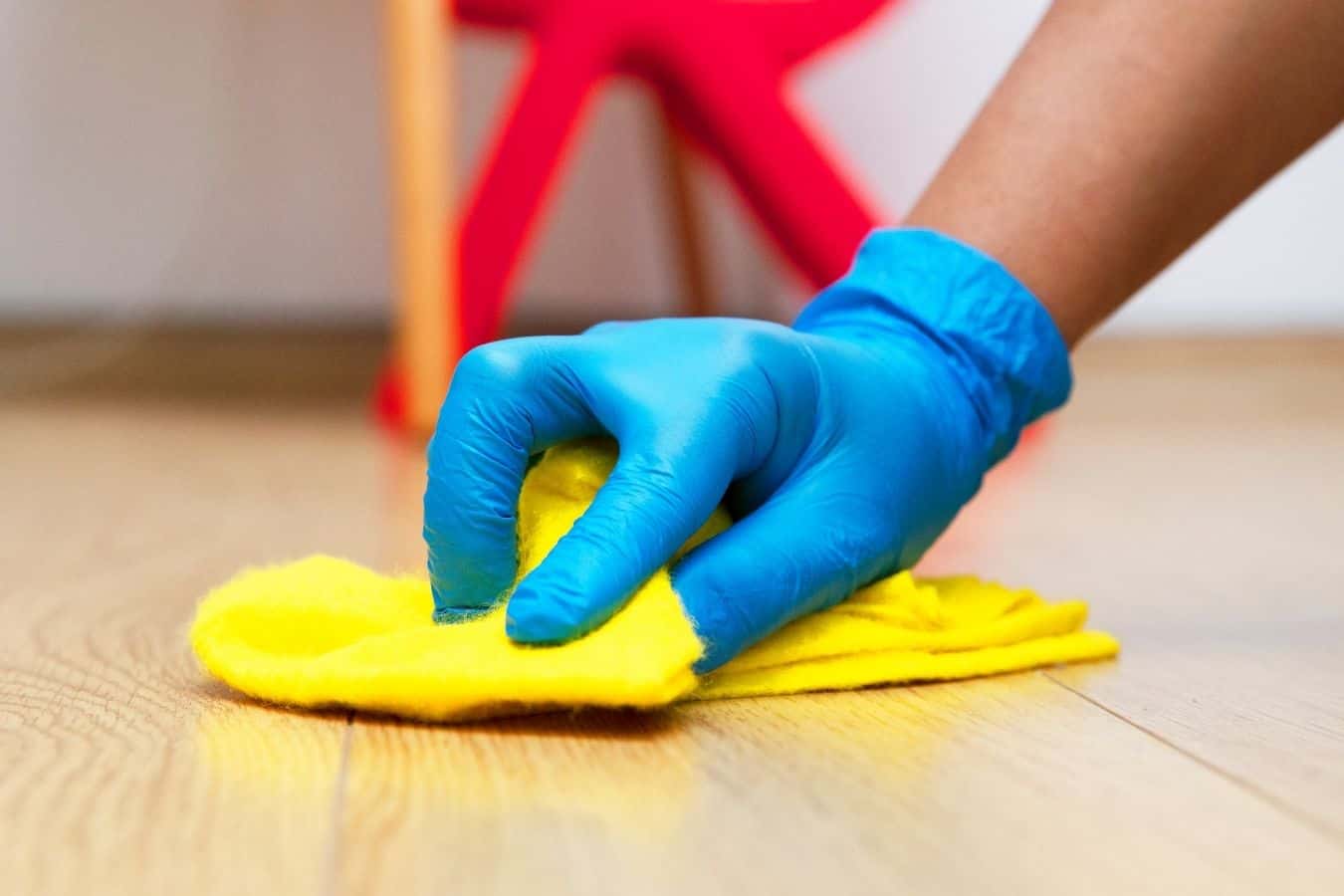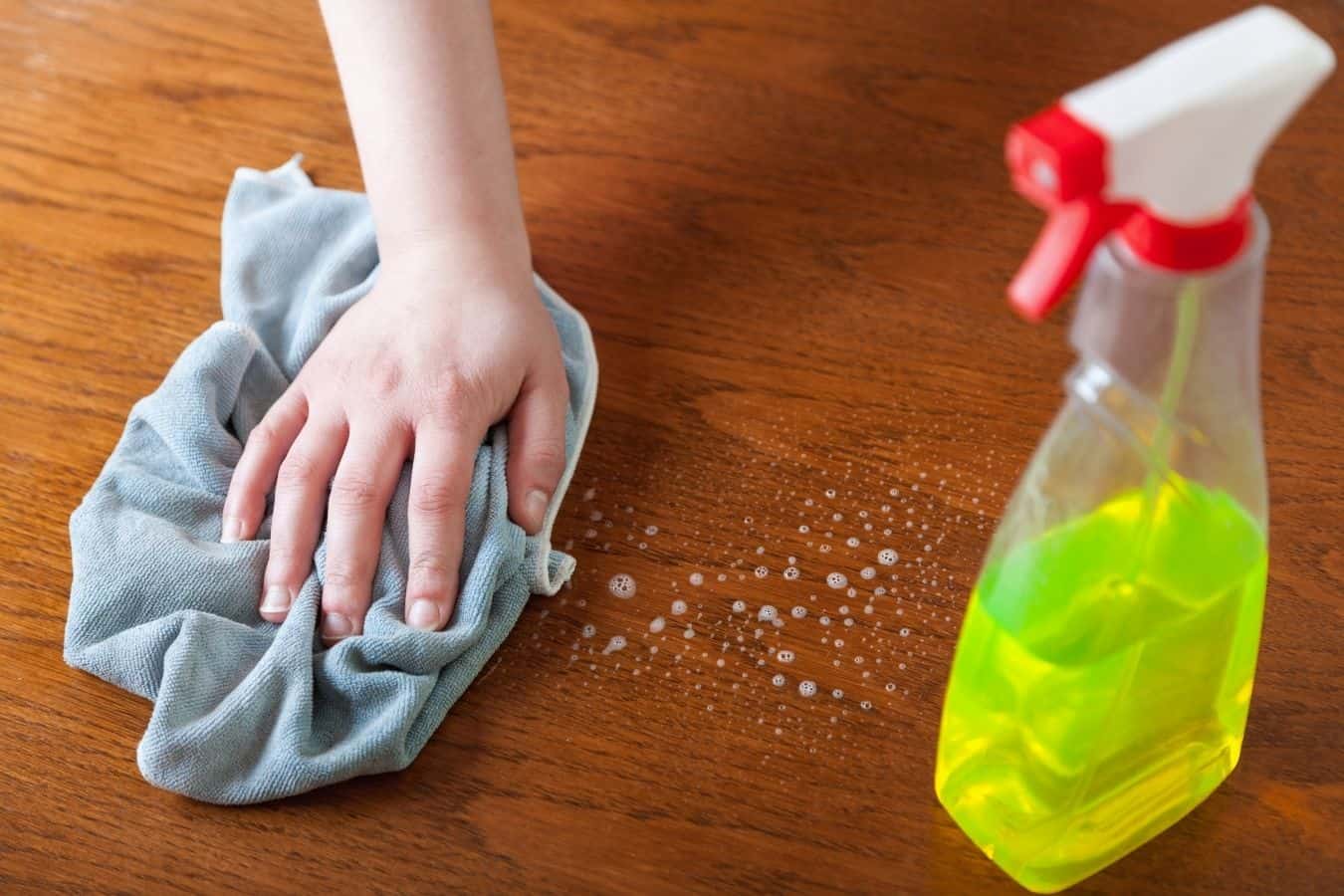You are rocking a beautiful new hair color, but your wooden counter, floor, or table fell victim to a spreading stain that seems impossible to remove. How do you get hair dye off wood? We’ve got the solution.

Hair dye can be removed from wood with the help of baking soda and various combinations of ingredients. However, it is important to try and prevent dye stains from occurring beforehand by preparing for hair dye.
This post contains affiliate links and we may earn if you click on them (at no extra cost to you). Please read our full disclosure policy here.
We’ll show you five proven ways to help clear your wooden furniture of stains, and advice on how to prevent hair dye stains from occurring.
Why Is Hair Dye Difficult To Remove?
Hair dye is designed to stay in a person’s hair and so color molecules bonds to the hair shafts while coloring the hair.
Permanent Hair Dye
Permanent color is most likely to stain wood. This is because the formula is designed to stay in the hair for long amounts of time.
A semi-permanent dye should leave a lesser stain that is easier to remove. Its purpose is to provide a shorter-lasting color than permanent dye and therefore fades after several washes.
Temporary Hair Dye
Temporary hair dye only coats the hair rather than fully penetrating it. This means it should be much easier to remove from wood.
These color formulas are what make hair dye so hard to remove from wooden furniture or flooring as the color soaks into the wood.
Luckily, many stains can be removed so it is a case of trial and error until you find the solution that removes the pesky marks on your furniture.
How To Prevent Hair Dye On Wood
You should cover any surfaces with old towels, newspaper, or plastic trash bags, and prepare a workstation before dyeing your hair.
Laying out your protective covers and using a bowl to contain any dirty brushes or gloves when dirty will help stop accidental staining of carpet or furniture due to carelessness or mistake.
Ideally, hair is to be dyed in the bathroom. This is where most surfaces are easy to clean due to their waterproof design.
This includes tiles and most sinks, bathtubs, and showers. This also makes it easier to quickly wipe away spray spots of dye and stop staining.
On all furniture, any spills should be wiped clean as fast as possible to prevent the stain from developing on your wooden furnishings.
Cleaning Finished Wood Vs Unfinished Wood
Before applying any products, homemade or manufactured, it is vital to determine the type of wood you are working with. Is it finished or unfinished?
Finished Wood
Finished wood has been sealed with a stain, varnish, paint, or sealant.
These can include nut oils, artificial chemical sealants and paint formulated to keep moisture from affecting the wood beneath. The wood will be smooth and shiny, with a rich color or paint.
A finished piece of wood will most likely shine underneath the light, with a dark or golden wood stain and a protective layer of varnish. Finished wood is, therefore, safer from problems such as moisture absorption. This is due to the layers of varnish over the wood itself.
These coats may help with hair dye stain removal by stopping the dye from penetrating the wood too far. However, certain cleaners may damage these finishes and cause the stain to become more prominent by lightening the area around the patch of hair dye.
A wooden piece of furniture or flooring with a dark finish will require extra caution when removing hair dye. The finish could be ruined and then the wood underneath the varnish will call more attention to the hair dye stain.
Unfinished Wood
In contrast, unfinished wood is matte and often pale like the natural wood of the tree it is made from.
It has not been sealed or finished, therefore rendering it more vulnerable.
You may find stains are worse on unfinished wood as it has no protective layer as finished wood does.
Water will also warp unfinished wood, so you must be careful to keep it dry and avoid using excess water when cleaning it.
How To Get Hair Dye Off Wood: 8 Proven Ways

1 Baking Soda and Dish Soap
Baking soda is one of the most common ingredients for removing dye stains on wood.
The alkaline nature of baking soda helps to dissolve water and grease by reacting with an acid, such as vinegar or lemon.
Using a tablespoon of baking soda, a tablespoon of dish shop and combining them with two cups of hot water will create a gentle but effective cleaning solution.
Soak a rag or cotton swab into the solution. Then tst it on a hidden patch of the wood first before attempting to remove the stain.
Gently rub into the stain. Repeat as many times as necessary.
The dish soap’s cleaning ingredients will help to break down the color in the stain, although it is important to rub rather than scrub at the dye stain.
2 Baking Soda And Lemon Juice
Baking soda is most effective when combined with an acidic element. In this recipe, mix two tablespoons of lemon juice into the baking soda to form a cleaning paste.
Apply this to a brush or cloth. Rub the hair dye stain until the mixture begins to reduce the stain.
The texture and chemistry of this mixture should help lift and fade the remaining hair dye.
3 Baking Soda And White Vinegar
This combination is best known for its use in model volcanoes for school projects, but its chemical reaction is what will help you remove that pesky hair dye stain from your wood.
Combine a couple of spoons of baking soda with a teaspoon of white vinegar to form a paste.
Play with the ratio as necessary, but the paste should be thick and not runny before being applied to the wood.
The reaction of the acid and the alkaline baking soda will foam and help penetrate the wood to remove the stain.
4 Baking Soda And Detergent
Fill a bowl with two cups or more of warm water. Add equal parts baking soda and laundry detergent with a tablespoon. Combine well and soak a cloth, brush, or swab in the mixture.
Avoid rubbing too vigorously as this may damage the wood and cause it to look worse than before you started.
5 Baking Soda And Hydrogen Peroxide
This is the most potent and damaging of the baking soda methods. This is because hydrogen peroxide is a strong chemical solution.
If the stain is not removable via other methods, combine equal parts of the peroxide and baking soda.
Form a thick paste and patch test on the wood in a hidden area before application on the stain. This is to make sure it will not make the stain worse by damaging the wood too much.
6 Rubbing Alcohol
Isopropyl alcohol, or rubbing alcohol, is concentrated alcohol that is used to disinfect or clean many surfaces. By soaking a cotton swab in the alcohol and slowly rolling it along the stain, it may help melt away the color from the wood.
This will not work for all hair dye stains. However, it could save you from a riskier clean with harsher chemicals if tried beforehand. This method is best for light stains but it could help to lighten up a dark stain before removal using another product.
7 Olive Oil
Olive oil is best used immediately after an accident with hair dye, after wiping the wood clean. The oil breaks down the hair dye and so if applied quickly, it may stop much of the staining. Olive oil can also be used to remove watermarks on wood when soaked in a cloth and used to rub the marks.
8 Chemical Cleaners
The Mr.Clean Magic Eraser from Amazon is a sponge made up of melamine and filled with chemicals to get harsh stains out from various surfaces.
These can be abrasive so wood should never be scrubbed on wooden surfaces. However, the chemicals and structure of the Magic Eraser may help the stain fade to the point of vanishing.
Sponges such as these are not recommended on varnish or similar finishes due to scratches. So make sure to test the sponge on a hidden part of the wood first to ensure it will not make the damage worse.
This product can be used in tandem with baking soda stain removers to its cleaning ability and help remove stains.
Disclaimer: This site is not intended to provide professional or medical advice. All of the content on LovedByCurls.com is for informational purposes only. All advice should be followed at your own discretion. Ingredients may change at any time so always check the product label before using. Check our full disclaimer policy here.
